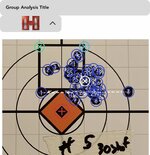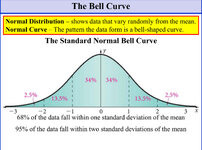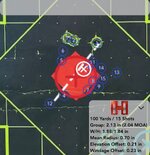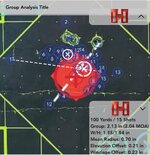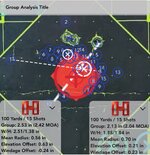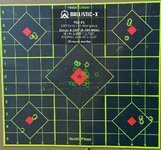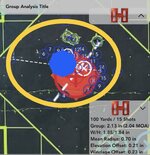Thanks for the thoughtful replies, all. Here are my results from a return trip to the range yesterday. I would greatly appreciate it if you could help me interpret what I'm seeing here. In a follow up message I will try to respond to other comments--including what I saw in Form et al.'s original data.
Here's the TL;DR: My rifle/shooter/ammo combo
appears to be more accurate when shooting five 3-shot strings than it is when shooting one 15-shot string. But in reality, my cold- and hot-bore shooting produced a similar MOA of around 2.5. This might be because I was breaking position between my cold bore shot-strings. Or it may be because I am an inexperienced shooter. Either way, none of this matters because my rifle is clearly more accurate than I am from actual field positions.
Setup:
It was 71 degrees yesterday, with a light (2-3mph) wind quartering from behind me. On the bench, the barrel of my Browning X-Bolt in 7PRC was exposed to the late afternoon sun. I was shooting with front and rear sand bags.
I was shooting at 100 yards so as to be able to estimate MOA accuracy the lazy way.
I could only afford to allocate 30 rounds for this test, 15 cold bore and 15 hot. A better test would involve more shots/datapoints. But these Barnes LR 160gr boxes ain't cheap, and I needed to spend at least 10 shots firing off of my bipod getting dialed in for next weekend's hunt. (More on that below).
Cold Bore 5 x 3-shot strings: 1 MOA, but with significant POI shift between strings.
The shot sequence for this cold bore test was to put 3 rounds on a 100 yard target in the top right corner, wait 10 minutes for the barrel to cool, then put 3 into the top left, then wait another 10 minutes, then 3 bottom right, then 10 minutes, then 3 bottom left, then 10 minutes, then 3 center.
Perhaps crucially, between each 3-shot string I broke shooting position and went over to the pistol range to shoot my Glock 20 to give the barrel 10 minutes to cool.
I found that after 3 shots the X-Bolt's sporter contoured, fluted barrel was on the verge of being too hot to touch and starting to mirage, but that after 10 minutes it was only slightly warm and giving off no mirage.
Here are the overall results, followed by my shot notes:
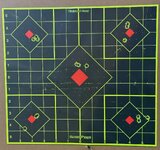 Top right (.75 MOA):
Top right (.75 MOA): First shot .5 inch low and left, next two shots .5 inch high-left and touching.
Top left (0.6 MOA): Three shots touching, half-inch low and right.
Bottom right (1.8 MOA): First and third shots right .75 inch, (pulled?) second shot 1.5 inches right
Bottom left (1.0 MOA): First shot low and left .75inch. Second and third shot touching high and right .5 inches.
Center (1.0 MOA): First shot inch high/right. Second and third shots touching 1 inch high. Stayed “in it” all three shots.
Average across five 3-shot groups: 1.03 MOA. Though it is interesting that the POI drifted. If I was to super-impose these five shot strings on top of one-another, we'd probably see an MOA of around 2.5.
While these results may appear similar to the 5-shot group results I posted a few days ago, these shot patterns are actually different. In those early ones, I was getting a tight grouping for shots 1 and 2, then another tight grouping for shots 3 and 4, then a wandering 5th shot.
In all but one of the shot strings yesterday, the very first and truest "cold bore" shot
appears to be wandering. The following two shots--call them "warm-bore"--were touching. This pattern was followed for all but the bottom-right shot string, where the first and third shots fell next to each other. I felt like I pulled that second shot, and almost fired a 4th shot to prove it. But I didn't want to change the methodology, as it might be mistaken for post-hoc rationalization and could look like I was trying to confirm my bias.
As you'll see below, the beginning of my hot-bore shot string followed this 1-off, 2-on pattern as well.
Hot Bore 15 shot string: 2.5 MOA, with more variation along windage than elevation.
My shooting notes indicate that the first, second, and third shots (cool bore) were half an inch high and left, and again the second and third shots were touching. From there, the next dozen rounds began following the first shots into the paper half an inch above the bullseye, achieving about 1.5 MOA except for a couple of shots that went wide, giving me an overall result of 2.5 MOA.
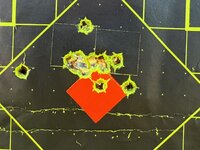
Here, as with several of Form et al's rifles, I note that the hot bore shots show a pretty clear bias along one of the axes--in this case horizontal deviation. While the vertical shot dispersion yielded an accuracy radius of about 1.5 MOA, the horizontal shot dispersion pushed me out to 2.5 MOA.
Pouring so much lead (copper, actually) into one aiming point definitely convinced me that I needed to adjust my zero (down 2 clicks). The curious thing is that the half-inch-high pattern was not what I observed across all the earlier, cold-bore shots. Had I decided to zero off of those 15 rounds fired in five 3-shot groups, I probably would've left my POI alone and not adjusted my zero. If I was operating based on the theory of cold-bore zeroing, that's exactly what I would do.
Instead, I chose to adjust my zero down based on the hot-bore groupings on the bet that Form et al. are correct. Either way, I think there are two plausible, non-exclusive explanations for the more consistent grouping observed during the hot-bore test.
First, I wasn't breaking position between shots for the hot-bore test, other than coming out of the scope to reload. This is the variable that
@wind gypsy alerted me to.
Second, as an inexperienced shooter it is possible that I was shooting cold in those first 15 shots. Once properly warmed up, maybe I was grouping more consistently.
But, for this shooter at least, none of the fretting I've been doing about hot-versus cold bore really matters a lick at this stage of my hunting journey because...
Epilogue: I suck at building a stable shooting position in the field.
I mentioned earlier that I saved the last 10 rounds from my two boxes to do some off-bench shooting from a kneeling position on my Spartan Precision bipod with 40 inch legs. This is the most common shooting position for me in the tall grasses of the West Virginia highlands where I hunt.
This was my first 3-shot string. All the same shooting parameters as before, but now from kneeling on a bipod.
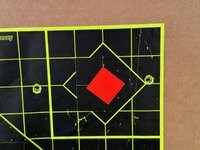
The MOA for this shot string is infinity because 1 shot missed the paper entirely

The second and third 3-shot strings faired a bit better as I settled in. But still, pretty embarrassing results.
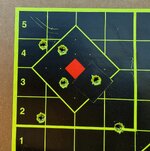
Here I was able to get all 6 shots on the paper. But I'm shooting at about 4 MOA from what should be a fairly decent field position (rifle fore-end stabilized on a bipod). That's "minute of deer" out to about 200 yards, which works for me in West Virginia. But it tells me that I have a lot of work to do before I head west to live out my Steve Rinella fantasies one of these years.
My big takeaways
First and foremost, my rifle is far more accurate than I am from field positions. Becoming better at establishing stable shooting positions in the field would be an infinitely more productive use of my time and energy than worrying about whether my rifle is sub-MOA when fired cold bore.
In terms of the cold vs hot bore tests, there are still too many variables in play for me to make any decisive conclusions.
Because I broke shooting positions between each of the shots in the cold-bore test, did that cause my POI to drift around the zero? I use a pretty hefty Spartan Classic bipod mount in place of my swing swivel stud. Perhaps varying fore-end flex caused by varying the position of the rifle on the front sandbag caused varying pressure on my otherwise free-floated barrel? Browning's polymer stocks are better than most, I am told, but they're not as good as non-polymer options.
The implication of this is not trivial. It would suggest that I have a 1 MOA rifle/shooter/ammo combination that is susceptible to POI drift depending on shooter/rifle positioning.
Alternatively, I think you could look at these drifting POI results and say "duh. Over 15 shots you are shooting a 2.5" cone at 100 yards. Your shooter/rifle/ammo combo is a 2.5 MOA combo. It just looked more systematic in these 3-shot groups because you were pointing at different corners of the target."
I am amenable to this argument. I think it is the one Form would make. But my hesitation is that the patterning in these cold bore shots appears to be SO consistent. Two shots touching, one errant shot, all inside 1.5"
There are probably other interpretations as well. This Lil-Rockslider welcomes feedback from the learned ones here.
Either way, I know that at this stage in my shooting career I need to focus my attention on building better shooting positions in the field. I didn't have my pack with me at the range yesterday. Maybe using it as a "rear bag" when firing from a kneeling position is the ticket. I am also considering switching to a tripod setup. Either way, I have some marksmanship fundamentals to work on.
Thanks for reading along. Again, I welcome all advice and perspective.

